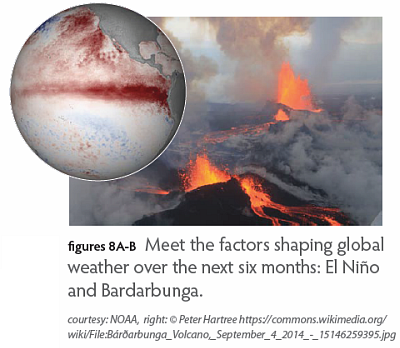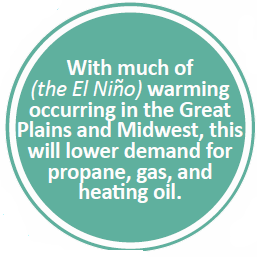The following is an excerpt of the Browning World Climate Bulletin, a key source of information in describing the relationship between macro weather-related trends and their potential impact upon energy, commodities, and the wider global economy. To subscribe to her monthly newsletter, click here.
 Summary: El Niño and the impact of the Bardarbunga eruption in Iceland should shape the Northern Hemispheric winter, creating warmer winter temperatures in North America and Western Europe. Meanwhile the strong El Niño will shape the growing season in the Tropics and the Southern Hemisphere.
Summary: El Niño and the impact of the Bardarbunga eruption in Iceland should shape the Northern Hemispheric winter, creating warmer winter temperatures in North America and Western Europe. Meanwhile the strong El Niño will shape the growing season in the Tropics and the Southern Hemisphere.
Over the next 6 months, two major climate factors will shape global weather. In the tropics is a strong El Niño event that some headlines have described as a “Godzilla El Niño.” To the north, swirling in the Arctic air, is the sulfuric debris from the giant eruption of Iceland’s Bárðarbunga volcano. The tropics and summer in the Southern Hemisphere will be shaped by the El Niño. Winter in the Northern Hemisphere could be shaped by the combined impact of both events.
El Niño
The current El Niño (Sometimes called a “Godzilla El Niño” in the headlines) is strong and expected to continue to be strong through winter and fade out in spring. As August drew to a close, an extremely hot (greater than 2.5°C or 4.5°F) area of water, called a Kelvin wave, flowed eastward through the center of the El Niño area, warming the center and eastern waters and allowing the western portion of the event to cool down to only moderate strength. This shift of temperatures is stirring up tropical winds and storms.
The warmth is extreme enough to distort weather around the globe. While its impact on the Tropics and Southern Hemisphere is somewhat predictable, it is difficult to know how it will interact with the debris from Bárðarbunga. Let’s examine what it typically would do to weather without interference from other climate phenomena.
The following maps are based on data and maps from NOAA and the Royal Netherlands Meteorological Institute.
Notice the most consistent impact of El Niños are around the tropics and Pacific Rim. In particular, when water temperatures change, monsoons change – strengthening and weakening different rainy seasons. This typically brings autumn drought to Central America, Indonesia and Australia, portions of Northern China and ends the Indian monsoon early. Southern South America, the Horn of Africa, parts of Spain, Portugal and Southern China almost always get heavier rainfall, with the Chinese precipitation usually being more typhoon landfalls. In North America, there is usually more autumn rainfall, but fewer hurricane landings in the southern tier of states and warm, dry conditions in Western Canada and parts of the Pacific Northwest.
Precipitation is only part of the picture. The warm offshore waters heat nearby land masses, making it hotter in India, Southeast Asia, Australia, and the western portions of Canada, Central America and South America.
Experts expect the El Niño to peak by the end of the year and its global impact to peak as well. This is when the greatest distortions of precipitation and temperatures typically occur. With the exception of causing cooling in Asiatic Russia, the Southern US and New Zealand, most of the event’s impacts are warming, especially in Africa, Asia and South America. In Asia, this warming weakens the winter monsoon, creating more precipitation in almost all areas but southern India and Southeast Asia. Australia and most of Africa except for the Horn are usually drier while South America is a complex mosaic. In North America, heavier precipitation and cloud cover usually cools the southern tier of states but most of Canada and portions of the northern states are warmer and drier.
The Blast From Bárðarbunga
The impact from El Niño has been studied. It is variable, but we are learning more about how to predict its potential impact. Similarly, volcanoes and their impact on climate have been studied. However there are many more variables and less is understood.
The basics for volcano eruptions are that when the blast reaches the stratosphere, the debris blocks out incoming sunlight. Much of the smaller debris become nuclei for water droplets, forming clouds. Both the debris and the clouds block out incoming sunlight, causing cooling. Global winds tend to carry the debris towards the poles. Eventually the droplets accumulate so much water that they precipitate out in rain or snow, usually causing blizzards, heavy rains and flooding. Mount Pinatubo, in 1991, cooled the entire globe 0.5°C (0.9°F) as its debris was carried north and south from the tropics. By 1993 most of the remaining debris was concentrated in the polar air mass and rained out, particularly in the US Midwest where it caused massive flooding.
Increasingly we are discovering that, just like real estate, location, location, location is tremendously important for determining the impact of volcano explosions. There have been relatively few studies about the impact of polar volcanoes on climate and most of those are on the much more common explosions in Russia and Alaska, not those in Iceland.
Secondly, Bárðarbunga, unlike the volcano eruptions that have been studied, was covered by a glacier. Vatnajökull glacier is over half a mile thick (850 m) covering the volcano and the melting glacier filtered out most of the particles so that the visible fountains of debris were only about 100 m high, about as high as the Statue of Liberty.
However the eruption, which lasted from August 31, 2014 to February 27, 2015 was the largest Icelandic eruption in two centuries. Its lava flow covered 33 sq. miles (85.5 sq. km), an area larger than Manhattan Island. According to Nature science magazine, the amount of sulfur it released stunned scientists, totaling more than 12 million tons, in the early months, more than the annual output of Europe. Sulfur gas easily mixes with water forming shiny reflective clouds and is the major chemical that creates volcanic cooling, even more so than the actual ash. While some scientists claim the sulfur was too low to affect climate, other scientists are not so sure. Gas rises and man-made sulfur pollution, which is released at much lower altitudes, produced massive cooling in Eastern Europe.
In short, scientists are divided on how much the Icelandic volcano will affect climate. If it does have an impact, it will only affect the polar and sub-tropical winter in the Northern Hemisphere.
Godzilla + The Volcano – The Impact on North America
The impact of a large El Niño, as shown in earlier figures, is to warm the Western and Northern tier of states and Western through Central Canada. If Bárðarbunga has the normal impact of a large Icelandic eruption, then it should heat the Southern and Eastern tier of states. Typically, the debris from a large Icelandic eruption cools the Icelandic low strengthening it. This typically creates a huge atmospheric pattern called a positive North Atlantic Oscillation – a pattern that creates a strong jetstream over Eastern North America, the Atlantic Ocean and Western Europe. The question is, as scientists note, whether enough sulfur from Bárðarbunga reached the stratosphere to do so.
 We saw this effect following the eruptions of Katla (1918), Hekla (1947 – 1948) and Grímsvötn (2011). All three eruptions took place when the Pacific Decadal Oscillation was negative, while the following mid-winter for the Katla and Grímsvötn eruptions were when the Atlantic Multidecadal Oscillation was negative and Hekla was when the Atlantic was positive. The mid-winter following Katla had an El Niño, Hekla was followed by a neutral Pacific and the recent Grímsvötn eruption was followed by a La Niña. None of the years are an exact match for the conditions we will be seeing this next winter.
We saw this effect following the eruptions of Katla (1918), Hekla (1947 – 1948) and Grímsvötn (2011). All three eruptions took place when the Pacific Decadal Oscillation was negative, while the following mid-winter for the Katla and Grímsvötn eruptions were when the Atlantic Multidecadal Oscillation was negative and Hekla was when the Atlantic was positive. The mid-winter following Katla had an El Niño, Hekla was followed by a neutral Pacific and the recent Grímsvötn eruption was followed by a La Niña. None of the years are an exact match for the conditions we will be seeing this next winter.
They all, however, have a strong jet stream over the Eastern portion of North America that kept the polar jet stream from dipping deeply into the Midwest and East Coast during mid-winter. Temperatures in the Midwest, Great Lakes portions of Canada, Northeast, Mid-Atlantic States and Southeastern Canada were warmer than usual. In 1919, when a large Icelandic eruption was accompanied by an El Niño, the entire Canadian/US Border state area and northern tier of states were warmer than average and most of the Southern tier of states cooler – the classic El Niño pattern.
In short, it looks as if the climate impact of a large Icelandic volcano does not block the climate impact of a large El Niño and may actually enhance it.
If this holds true, then heating demands in the crucial Midwest, North East, Mid-Atlantic and Southeast Canada will be lower this winter. History suggests that, with much of this warming occurring in the Great Plains and Midwest, this will lower demand for propane, gas and heating oil.
Source: Browning World Climate Bulletin
Related:
The Economic Consequences of El Niño – North America







